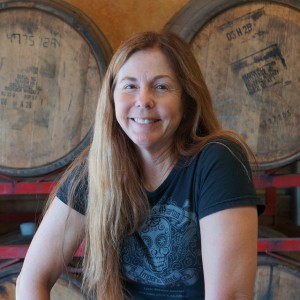
Claudia Faulk, Owner of Aztec Brewery
An Interview with Claudia Faulk, Owner of Aztec Brewery
Claudia Faulk earned a degree from SDSU in graphic design/multimedia, and earned a master’s degree in educational technology. She and her husband started their own graphic design business, Webster Design. Faulk also works at MiraCosta College as an associate professor – she teaches beginning web development and social media for business.
After years of promoting other businesses, Faulk and her husband wanted to have their own product. “Friends suggested to get some widget made in China, but we wanted something made in America. What’s more American than craft beer? We decided to start up a brewery,” she says. They started by learning to home-brew, because she believes that you should have at least a basic understanding of what a business is all about.
What makes brewery startup different from starting up any independent business?
I assumed at first that it would be pretty similar to running our graphic business. But it’s more complex, and you need more people to work from one end to the other in a brewery. We had employees in our graphic business, but the focus is much more narrow. You have to work smart. The profit margins are slim. From the outside people might see the coolness factor. Rock star and brewery owner – both are pretty awesome job descriptions, but both take hard work to get there. And there is no guarantee of success.
Why should people take your class Brewery Startup?
I am a big believer in lifetime learning, and craft beer has grown so much. There is so much to learn, from the diversity of flavors to skills needed to manage and grow the business. It’s a complex business. If you come into it with unrealistic expectations, you could get sideswiped by reality. I’ll admit we were pretty naive when we started out. It’s not a 9-5 job. It’s a major commitment of time and money.
What are the complexities of starting a brewery in San Diego?
The craft beer business is one of the most regulated businesses in the U.S. There are piles of paperwork. Luckily you can reach out to the breweries that started before you. We did that, and received great advice. We try to pass the favor on too. Figuring out how much money you will n need is complicated. It’s easy to grasp the large purchases, but there are always extra unexpected costs that mount up fast. Deciding which route you want to point your business can be difficult too. You need to think way beyond a typical five-year plan to even set short-term goals. And, importantly, just because it is easy to get into a city, does not mean it is easy to run a business and make a profit there. As the number of breweries increases per area, customers no longer have to venture as far to have a brewery adventure. The consumer is happy because they have ten breweries in their backyard. That affects the bottom line if you are depending on your tasting room.
What makes a great craft beer?
Passion. You need to listen to the people who drink your beers, and be willing to take a chance on doing something different. Reach to make the beer better – even if that means making it consistent. Deciding the type of beer you make depends on you… but you also have to listen to your consumers. Just as in any field of art, there is a different answer for every person who drinks the beer. Some people prefer light, crisp clear beers, and at the other end of the spectrum there are those who prefer a bold, dark beer whose flavors increase as you slowly sip and enjoy it. I am not a beer judge. I do like flavor. Being able to close your eyes and think how the beer smells and then feels in your mouth. And being able to say WOW! Sometimes you just want to say – that is so refreshing. I won’t claim to be a brewer, but I have home brewed and like to think up ideas for beers. We all brought at least one recipe in when we started Aztec. Mine was the Chipotle IPA. I think they kept making it to humor me, but it has become one of our top-selling beers. I wanted something subtle that makes people stop and think while they drink it. Not all craft beer has to be in your face.
What’s it like to be a woman in a male-dominated field?
I have never been interested in working in a job that is seen as typically a female field. I am no stranger to playing that role. When I got into the graphics business people would assume I was the secretary, so I had to work harder and smarter and prove myself over and over. That made me a stronger person. I am not afraid to stand up and ask questions when they need to be asked. I played the bass in a rock band. And, now craft beer. I am involved in the community, locally the Vista Brewers Guild and now the San Diego Brewers Guild. I am trying to learn as much as I can about the beer and the business from all sides. The most frustrating part for me is when someone asks if my husband is one of the owners and I’m ignored. So now I will say, “Yes, he is and he is also married to one of the owners.” Makes them stop and think and sometimes laugh. Better to do that than get angry. Women supposedly have much better palates and were the first brewers. my husband laughs when I close my eyes and think about the taste in my mouth and describe it.
What is the future of craft beer?
Who can really say? It’s a hot trend right now. Will we reach a saturation point? In some ways we could. But there is plenty of room for more craft beer drinkers. As the variety of flavors expand, the ability to pair with all types of foods, from appetizers to desserts grows too. It’s a great business to be in. Craft beer is an affordable luxury. You can go out with friends for an evening, have a great time, and spend less than $20. As a community, the local craft beer enthusiasts can all educate others in the pleasures of craft beer. Get them to take the first step into the wild side. Expand their palate. Help them find their WOW! moment.
Why craft beer?
I’ll repeat myself. It’s such a great American product. It’s become such a phenomenon that the big beer guys are standing up and taking notice and changing their game. Even the traditionalists from Europe are becoming more interested in collaboration brewing with American brewers. It bring




